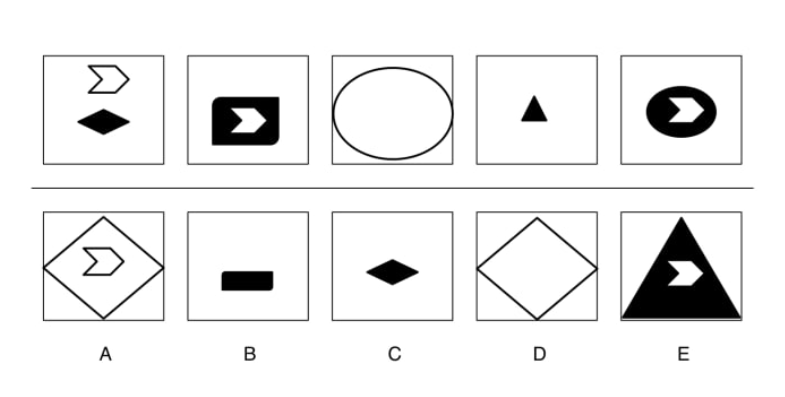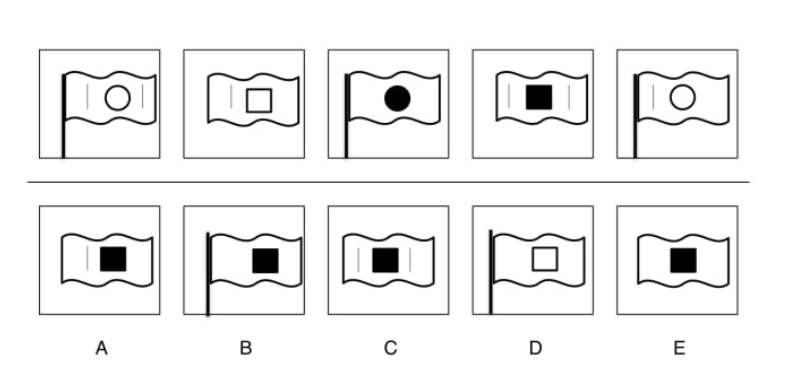Is very user friendly. But I believe the timing is too forgiving. Most tests have 1 minute or less per question.
What are Inductive Reasoning Tests?
Inductive reasoning tests are a form of psychometric assessment often used in the recruitment process for a number of roles, often alongside other reasoning tests like verbal and numerical reasoning.
Sometimes known as abstract or diagrammatic reasoning, inductive reasoning tests are used to assess your ability to make logical decisions based on unfamiliar information, by spotting patterns in a sequence of images.
This form of non-verbal reasoning is an important skill for high-level positions and is often found in the recruitment process for technical roles like engineering and IT.
How Do Inductive Reasoning Tests Differ from Deductive Reasoning Tests?
Inductive reasoning and deductive reasoning are two different skills, and the tests that are used to assess your ability in each are also different.
Inductive reasoning assesses your ability to use specific information to form a generalised conclusion. This form of logic takes into account all available information to draw a conclusion that fits. Inductive reasoning assessments usually take the form of a series of images that follow a sequential pattern, and you will need to find a missing image.
Deductive reasoning, on the other hand, is the skill of being able to take general information and working through it to find a specific conclusion. These assessments usually take the form of a series of statements, with a conclusion. You need to decide if the conclusion follows.
What Types of Questions Can I Expect on an Inductive Reasoning Test?
On an inductive reasoning test, you are likely to find a series of questions relating to a sequence of images, with multiple choice answers.
The images will all be linked by a particular pattern, and this is the set of rules that you will need to quickly find and apply to choose the missing image among the possible answers.
The pattern might involve repetition, rotation, reflection or translation as well as replacement. In some cases, the pattern could be formed from more than one of the above, making it a little more complicated.
What are Inductive Reasoning Tests Used For?
As with other psychometric assessments used in recruitment, the inductive reasoning test is used to identify candidates who have the right skills and competencies for the role.
It is simple to administer and allows for fast and accurate testing that is not biased and effective in identifying those who are suitable to take further in the process; allowing for a quick and easy way to reduce a candidate pool.
Inductive reasoning tests, in particular, are used to assess candidates on their ability to work with unfamiliar information, problem solve, and reach logical conclusions under pressure. They also assess a candidate's ability to work methodically to find an answer, which is why these assessments are often found in the recruitment process for more technical roles.
How are Inductive Reasoning Tests Formatted?
Inductive reasoning tests come in several different formats, depending on the publisher and the role applied for.
The most common type of question will be in the form of a matrix , a 3x3 or 4x4 square containing a number of images that are all linked with a specific pattern.
Other inductive reasoning tests might use a horizontal row of images instead. In a similar way to the matrix, the images will be linked by a specific pattern, and you will need to find the missing image in the sequence or the image that continues the pattern.
In some cases, you might be presented with a matrix or a horizontal row of images where instead of finding the one that is missing, you need to identify the image that is the odd one out.
More rarely, the images might be in an A/B Set where each set has a different pattern, but of the same type - such as a shape that represents a number, for example.
It is usually the case that each sequence of images will have multiple choice answers for you to select.
Top Tips to Prepare and Pass Your Inductive Reasoning Test
1. Practice
One of the easiest ways to prepare yourself for any assessment is to practice, and the unfamiliar nature of the inductive reasoning test is one reason that candidates find it challenging.
If you know the publisher of the test you will be taking, find practice assessments designed for that publisher - otherwise, find general inductive reasoning practice tests to practice.
Practice will help you feel more comfortable with the type of questions being asked and allow you to develop your pattern identifying skills.
2. Exam Conditions
If you can, make sure that every practice test you take is under exam conditions. Set a timer so you get used to working under pressure, make sure that you are somewhere that you won't be disturbed, and turn off notifications.
It is normal for nerves to happen when you are in a test, but the more used to it you are, the more confident you will feel.
3. Take Your Time
You are likely to feel under pressure in a timed test, and this might make you rush through the questions. If you can, work out how long you will have for each question and make full use of that time to answer (if you need to) - so that you can avoid making any mistakes.
4. Get Used to Spotting Patterns
Our everyday lives are governed by patterns and sequences, and you can 'tune in' your inductive reasoning skills by spotting them around you.
A great way to practice spotting patterns is to complete puzzles, especially 'spot the difference'.
Inductive Reasoning Practice Questions
Q1) Which of the boxes comes next in the sequence?
Q2) Which of the boxes comes next in the sequence?
Solutions
Q1) Answer = A
Rule 1: The shapes alternate from small, medium to large and repeat. Rule 2: The small chevron alternates between being present and absent
Q2) Answer = E
Rule 1: The shapes on the flag alternate between circle and square. Rule 2: The flag pole alternates between being present and absent. Rule 3: the shapes on the flag alternate between being shaded and unshaded, that is 2, shaded, 2 unshaded.
Jump to a section on this page:
- What are Inductive Reasoning Tests?
- How Do Inductive Reasoning Tests Differ from Deductive Reasoning Tests?
- What Types of Questions Can I Expect on an Inductive Reasoning Test?
- What are Inductive Reasoning Tests Used For?
- How are Inductive Reasoning Tests Formatted?
- Top Tips to Prepare and Pass Your Inductive Reasoning Test
- Inductive Reasoning Practice Questions
- Inductive Reasoning Tests Sample Questions
- Inductive Reasoning Tests Tips
- Inductive Reasoning Tests FAQs
Sample Inductive Reasoning Tests question Test your knowledge!
Which word completes the series? Book, ..., Ledger, Journal
- Record
- Page
- Magazine
- Diary
Fintest is not the cheapest, but definitely the best.
Virat used Fintest to help pass her aptitude tests for Santander.

Inductive Reasoning Tests Tips
- Get Familiar with Patterns
Inductive reasoning is all about patterns and sequences, so spend some time recognizing different types of patterns. Whether they are numerical, abstract, or diagrammatic, getting a good grasp on pattern identification is key. You can start with simpler sequences and work your way up to more complex ones as you become more confident.
- Internalize the Logic
Understanding the 'why' behind a pattern can be more useful than simply recognizing it. When practicing, take a moment to figure out the underlying logic. This understanding will go a long way when you face a new pattern on the actual test because you'll have a strategy for decoding it, rather than just a memory of similar patterns.
- Time Management
These tests are often timed, which can add a level of pressure. Practice under timed conditions to get a sense of the pace you need to maintain. Remember, quality trumps quantity – it's better to answer fewer questions correctly than to rush through many with errors. If you find yourself stuck, it might be best to move on to the next question.
- Don’t Overthink It
Inductive reasoning tests are designed to measure your natural ability to recognize and follow patterns. Therefore, if you find yourself overanalyzing or second-guessing, take a step back. Sometimes the answer is simpler than it seems, so trust your instinct after you've made your initial assessment.
- Stay Calm and Positive
Your mindset can greatly influence your performance. Practice staying calm and focused under testing conditions. If you feel anxiety creeping in, take a few deep breaths to center yourself. Keeping a positive attitude will help you think clearer and perform better on the exam.
Level up
Choose the package that works for you.
Pro
- 12 Aptitude packages
- 20 Admissions packages
- 162 Employer packages
- 17 Publisher packages
- Dashboard performance tracking
- Full solutions and explanations
- Tips, tricks, guides and resources
- Access to free tests
- Basic performance tracking
- Full solutions and explanations
- Tips and resources
Inductive Reasoning Tests FAQs
- Can you get better at inductive reasoning tests?
In a nutshell, yes you can get better at inductive reasoning tests - through practice. Logical thinking doesn't come easy to everyone, but this is a skill that you can improve by taking practice assessments and getting used to spotting patterns quickly.
- What jobs use inductive reasoning tests?
While inductive reasoning tests are often part of the pre-employment assessment battery for most industries, there are certain job types or roles where they are more likely to be found. These include:
Engineering
Coding and Programming
Production
Legal
Banking and Financial
You are likely to come across an inductive reasoning test if you are applying for high-level positions like management, and especially in graduate recruitment.
- What do inductive reasoning tests measure?
Inductive reasoning tests measure a candidate's ability to make logical decisions under pressure using specific information.
They are a good indicator of a high level of critical reasoning ability too, as well as general cognitive ability.
- Why is inductive reasoning important?
Inductive reasoning is an important skill in many roles, and those that are good at logically and methodically working their way through new and unfamiliar information to make a reasoned decision usually perform well in technical, hands-on roles as well as management.
Reviews
What our customers say about our Inductive Reasoning Tests
Louise Dantas
Netherlands
June 01, 2022
Medium difficulty
ALICE MUMBI Ngari
Kenya
November 08, 2022
like
it's very thoughtful and helps to think beyond office work. It's a good test for one's understanding and diversification of knowledge in different categories for the said field.
Zainab Zakirah Abdul Halim
Malaysia
March 14, 2023
Logical reasoning
I like how it uses our common sense and logical reasoning with addition of fun pictures. Makes it interesting and fun game to play and learn.
Oloyin Roqeebat
Nigeria
June 28, 2023
Inductive argument and shapes stuff
I like the fact that it makes me reason well and look at the question again and again before choosing my answer






